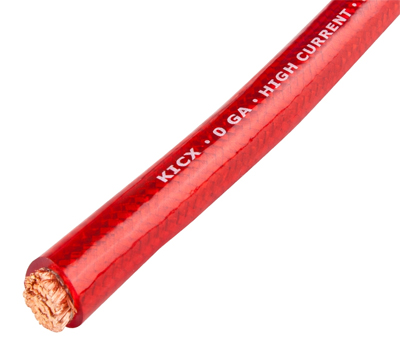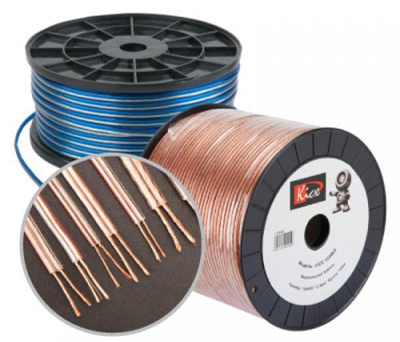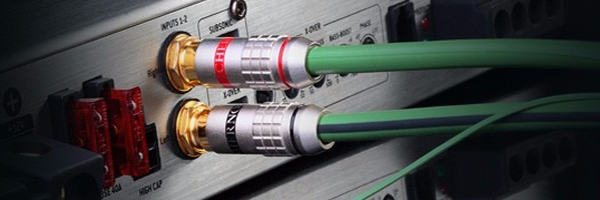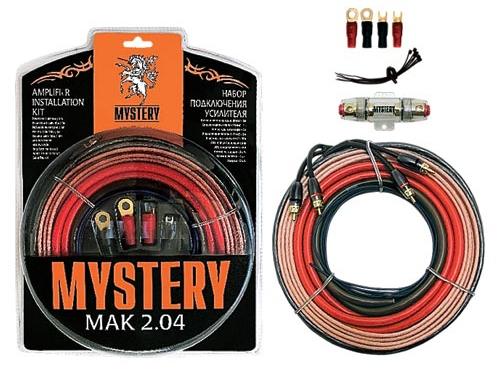We select wires for connecting the music system in the car
We independently test the products and technologies that we recommend.

As in almost any other technical field, the choice and purchase of car wiring should begin with a small "theory". Three types of cables should be suitable for the car amplifier:
1) power, deliver an electric current to the amplifier with a voltage of 12 volts (with the engine running 13.7 — 14.2 volts);
2) signal interlocks (coaxial), their function is to transmit a low-voltage audio signal from a preamp (radio) to an external amplifier;
3) acoustic cables, conduct an amplified signal to the speakers.
All amplifiers have three power connection terminals (+, — and REM). The last terminal is used to connect the cable that controls the on/off of the amplifier. Especially so that the amplifier is not constantly powered by the battery and does not discharge it. This cable is called a control cable (remote).
Power and acoustic cables have the same structure, but differ only in insulation and cross-section (the number of wires conducting current, or, more simply, the thickness of the cable). Their pricing is influenced by several factors. First of all — the material of manufacture. Basically, copper and aluminium are used in car audio, and there are also cables made of silver and steel. The most expensive cables are silver, copper — a little cheaper, aluminium and steel cables are the most affordable.
Materials from which cables are made
 |
| Copper usually serves as a conductor in all types of cables |
Silver cables. Stranded silver acoustic cable with a high degree of 99.99% purity is rarely found on the market, as is silver-plated copper (where each copper cable vein is covered with a layer of silver). Silver as a conductor has better conductivity, but there is an opinion among fans of high-quality sound that silver wires embellish the upper frequency range. For acoustics with a not very sensitive squeaker, the use of silver cables (both acoustic and interblock) will benefit to compensate for this disadvantage — to equalize the amplitude-frequency response (frequency response). And yet, most enthusiasts prefer to sound their acoustics with copper acoustic cables, since they are considered neutral in terms of sound and are cheaper than silver.
Copper cables. Among copper cables, solutions made of oxygen-free copper with a high degree of purification of 99.9999% (OFC) are the best. Because they have low resistance to alternating current flowing through them (in acoustic cables) and direct current (in power cables). With such cables, the system will work optimally — the sound will be loud and high-quality.
Tinned copper. Copper cables can have the colour of aluminium if they are tinned. Tinning the cable with tin alloy (sometimes with silver additives), protects it from contact with the environment. A cable covered with a thin layer of tin is better soldered and does not oxidize, which is important for the conditions of using cables in a car (where there is high humidity, temperature changes and vibration). In general, tinned copper is more durable in such conditions.
Aluminium cables. Chinese aluminium wires attract the attention of buyers with a large assortment, low price and bright insulation of cables. In addition, they weigh less than copper ones. This is where the advantages of aluminium cables end. Aluminium has twice the resistivity than copper. And to provide the amplifier with sufficient power, you need to use aluminium cables almost twice as thick as copper. For example, for normal power supply of an automobile amplifier (with a rated power of 50 watts for 4 channels), a copper power cable with a cross section of 10 mm² is enough from the battery, and an aluminium cable should have a cross section of 21 mm².
Compared to copper cables, aluminium cables oxidize much faster, and primarily at connections. Basically, automotive connections (on amplifiers, distributors, subwoofers) are used in the form of screw clips that cannot fix the aluminium cable for a long time. After all, aluminium is flattened under pressure, which leads to an increase in resistance at the contact point, heating and accelerated oxidation of the cable. As a result, after a while the audio system plays worse and quieter, and then it may stop working altogether. This is corrected at best by cleaning the connections, and at worst by replacing the cables (now, most likely, with copper ones), since the rotted aluminium wires have become shorter and do not reach the connecting terminals.
 |
| Acoustic cables can be purchased in almost any required length |
It is difficult to distinguish aluminium cables from copper at first glance, since copper-plated aluminium wires are mainly sold. There are two ways of copper plating aluminium cables, which have the same abbreviation CSA. Sorreg Coated Aluminium (aluminium coated with copper) and Sorreg Clad Aluminium (aluminium clad with copper). Cables of the first type contain 9% copper (a very thin surface layer) and 91% aluminium, and a more sophisticated copper cladding technology allows you to make higher-quality cables with a content of 30% copper and 70% aluminium.
You can distinguish a copper cable from a copper-plated one on a slice: the latter will be silver inside. And the copper content in the cable is difficult to visually determine. It is worth considering the price of cables — copper-plated cable clad method will cost more. For example, the company Sound Quest, which is a subsidiary of the American Stinger, has cables with 30% copper content. And the latter offers car owners acoustic and power cables only made of oxygen-free copper or tinned copper with an alloy of silver and tin. Chinese manufacturers (Mystery, Kicx, Autofun, etc.) offer a larger range of cables with 9% copper content.
Wire insulation
Cables are covered with insulation for two purposes. The first is to prevent the conductor from contacting the metal. Second: protecting the wire from the external environment and increasing its strength. Silicone insulated wires are used in cars. The temperature range of long—term use of silicone is from -60 °C to 180 °C degrees (and short-term — up to 220 °C).
Selection of the power cable section
The cross section of the cable is its area in the section without taking into account the insulation. In the USA, the thickness of cables is marked in gages (gauge — from English size, caliber) according to the "inverted" AWG system (American Wire Gauge). In it, a smaller number means a thicker cable. The designation system adopted by us in square millimetres (mm²) is simpler.
The comparative table of sections shows the corresponding values in the two systems. And also the nominal value of the fuse (located under the hood no further than 40 cm from the battery terminal), which protects the cable from overheating, and not the amplifier, as many mistakenly believe.
| Cross-sectional area, sq. mm | Cable gauge AWG | Maximum fuse rating, A |
|---|---|---|
| 0,5 | 20 | 5 |
| 0,75 | 18 | 7,5 |
| 1 | 17 | 10 |
| 1,5 | 15 | 15 |
| 2,5 | 13 | 25 |
| 4 | 11 | 30 |
| 6 | 9 | 40 |
| 8 | 8 | 50 |
| 10 | 7 | 60 |
| 16 | 5 | 80 |
| 20 | 4 | 100 |
| 25 | 3 | 125 |
| 30 | 2 | 150 |
| 50 | 0 | 200 |
| 70 | 000 | 250 |
| 95 | 0000 | 300 |
To find the right "caliber" of the power cable for the amplifier, you first need to calculate how much this device consumes. To do this, add up the rated power of all its channels, multiply it by two (calculating the maximum power for class AB amplifiers, whose efficiency is approximately 50%) and divide by 13 (the average value of the voltage of the vehicle's bot network when the engine is running and turned off). For example, the consumption of a standard 4-channel amplifier with a rated power of 4x50 Watts is calculated by the formula: 50*4*2/13 = 30. That is, this amplifier consumes 30 amperes of current.
Then we determine the location of the amplifier in the cabin: if it is placed under the front seats, the length of the power cable will be about 3 m, and if in the boot – 5 m. Then, knowing the length of the power "plus" cable and the consumption of the amplifier (or amplifiers), we use the table to select the "caliber" of the power cable.
| 300-225 A | 1 Ga | 1 Ga | 1 Ga | 1 Ga | 1 Ga | 1 Ga | 1 Ga | 1 Ga |
|---|---|---|---|---|---|---|---|---|
| 225-150 A | 2 Ga | 1 Ga | 1 Ga | 1 Ga | 1 Ga | 1 Ga | 1 Ga | 1 Ga |
| 150-125 A | 2 Ga | 2 Ga | 2 Ga | 2 Ga | 1 Ga | 1 Ga | 1 Ga | 1 Ga |
| 125-105 A | 4 Ga | 4 Ga | 4 Ga | 2 Ga | 2 Ga | 2 Ga | 1 Ga | 1 Ga |
| 105-85 A | 4 Ga | 4 Ga | 4 Ga | 2 Ga | 2 Ga | 2 Ga | 2 Ga | 2 Ga |
| 86-65 A | 4 Ga | 4 Ga | 4 Ga | 4 Ga | 2 Ga | 2 Ga | 2 Ga | 2 Ga |
| 65-50 A | 8 Ga | 8 Ga | 4 Ga | 4 Ga | 4 Ga | 4 Ga | 4 Ga | 2 Ga |
| 50-35 A | 8 Ga | 8 Ga | 8 Ga | 4 Ga | 4 Ga | 4 Ga | 4 Ga | 4 Ga |
| 35-20 A | 8 Ga | 8 Ga | 8 Ga | 8 Ga | 8 Ga | 4 Ga | 4 Ga | 4 Ga |
| 20-1 A | 10 Ga | 10 Ga | 8 Ga | 8 Ga | 8 Ga | 8 Ga | 8 Ga | 8 Ga |
| 0-1.2 m | 1.2-2.1 m | 2.1-3 m | 3-4 m | 4-4.9 m | 4.9-5.8 m | 5.8-6.7 m | 6.7-8.5 m |
The body of the car is the grounding for the "minus" power cable, therefore, the power grounding cable of the amplifier is usually less than 1 metre, but despite this, the caliber of the "minus" cable must correspond to the caliber of the "plus" cable calculated according to the table.
The cable responsible for turning the amplifier on and off (it is blue in the opening of the radio) may have a cross-section (0.75-1.5 mm²) since it passes a small current. In some cheap interblock cables, this wire is included (connected with insulation), but it is not advisable to use it, because it is very thin (0.25-0.5 mm²) and easily breaks when laying interblock cables or when it wears out over time. So it is better to stretch this cable separately, and together with power cables, and not sound (signal and acoustic).
Selection of the acoustic cable section
There is no exact table for selecting the section of the speaker cable. Everything depends not only on the thickness and length of the cable, but on a much larger number of parameters of the amplifier, acoustics and cable. Therefore, the recommendations of some power amplifiers give an approximate "caliber" of the cable.
Note that the thicker the cable, the less resistance it has to the passage of an audio signal (in the form of alternating current). The use of thick acoustic cables in a car can be hindered by several factors: the difficulty in laying them (for example, through doorways), their higher cost and not very noticeable effect on the sound of cables with low resistance.
The simplest selection of the section of the acoustic cable is to find a match to the "caliber" of the power cable. If according to the selection table of the "caliber" of the power cable 4 Ga came out, then the acoustic should be 13 Ga, and if the power is 8 Ga, then the acoustic is 15 Ga. This is the most common combination of cable length and amplifier power. If you have the "caliber" of the power cable 2 Ga according to the table, then it is advisable to use an 11 Ga speaker cable. And a 10 Ga power cable may be enough, only if a low-power amplifier is located under the torpedo, but this option of installing an amplifier is very rare.
Interblock (signal) cables
The cables connecting the radio and the amplifier are called interblock (because they are located between two blocks). These cables should transmit a low-level audio signal with minimal losses. Their pricing is influenced by the quality of manufacture, protection from interference and the accuracy of the transmission of musical material.
Interblock cables usually have a design — coaxial or twisted pair. Coaxial cables are more often used, where the central core is located exactly in the centre of one or more screens. Like in an antenna TV cable. Interblock cables are sensitive to electromagnetic interference generated by power wires, so they are shielded.
In an interblock cable, the signal is transmitted via two contacts, where the "plus" is the central core, and the "minus" (usually in inexpensive cables) is the cable screen itself. But the "minus" also transmits an audio signal, so using a screen as it reduces the cost of the cable, but negatively affects the accuracy of the audio signal transmission.
 |
| Tchernov Audio cables — high-quality solutions for high-level systems |
In more expensive versions of cables, which are called pseudo-balanced, an additional external screen is used, which is connected to the "minus" only from the source side. Balanced cables usually indicate the direction of their connection to the amplifier in the form of arrows. But practice shows that it is not always necessary to ground the screen from the source (radio). Sometimes grounding on the side of the amplifier allows you to remove the engine guidance more efficiently, and sometimes the external screen should hang in the air and not touch the "minus" on both sides.
Another way to protect interblock cables from electromagnetic interference is twisting two cable cores (twisted pair). This type of anti-interference protection is used by Stinger for almost the entire line of its interblock cables. The twisted pair design is also used for acoustic wires, but rarely. Since the acoustic cable has a high signal level (10-20 volts), and the captured leads from the running engine are too low in level for the driver and passengers to hear them. And for interlockers that pass a low-level signal (2-4 volts), such leads can worsen the sound.
 |
|
A set of wires from Mystery can be an inexpensive solution the question of the selection of cabals, although it is not suitable for all systems and machines |
Consider a few nuances about the cuts. First: short RCA connectors are sometimes relevant for car amplifiers due to the proximity of amplifiers or other interior surfaces. Second: the gold-plated or chrome-plated coating of the RCA connectors should ideally match the coating of the sockets where the RCA connectors are connected. That is, a chrome-plated RCA connector will have the least resistance in a chrome-plated socket than in a gold-plated one. Third: the split centre pin of the RCA connector provides a tighter connection. Fourth: the collet design (where the petals of the "tulip" are compressed when the outer housing of the RCA connector is twisted) securely fixes the RCA connector in the socket of the linear output.
So, when choosing an interblock car cable, the role of:
1) noise immunity(one or more screens, or better a twisted pair in several screens);
2) the material of the signal conductors (silver, copper, aluminium, steel). This information can sometimes be found out from the technical specifications specified by the manufacturers. This is especially true for non-disassembled models with RCA connectors;
3) the quality of the RCA connectors ("tulips") and the quality of the connection (soldering) of the cable with the connectors.
Separation of interblock cables into price categories
The weak point of all low-cost interblock cables is the poor—quality connection of the cable with RCA connectors, which easily break off during use. Therefore, such cables can be called disposable. The mid-range models have reliable RCA connectors, decent noise immunity and satisfactory audio signal transmission. Top models cables can have four levels of protection against interference. They have silver or silver-plated copper cores that transmit sound without loss, and RCA connectors that are very securely fixed in the sockets.
A good knife is useful in hiking, hunting, repairs and many other life situations.
We compare the capabilities of routers from Huawei, TP-LINK and NETGEAR.
Are you afraid to take your expensive smartphone on a hike or to the sea? Maybe it's time to buy a secure smartphone?
We compare compact models for cleaning in the car and at home.
It is also not easy to connect and configure the amplifier correctly, as well as to choose a model for purchase.

